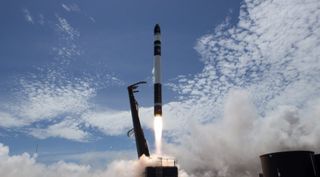Rocket Lab Launch Also Tested New Kick Stage
SOUTH SAN FRANCISCO, Calif. – The successful launch of Rocket Lab's Electron rocket Jan. 20 also tested a kick stage designed to circularize the orbits of its satellite payloads.
The company said Jan. 23 that the Electron carried a kick stage for the two Lemur-2 cubesats it launched for Spire. The kick stage separated from the Electron's upper stage and, after a 40-minute coast phase, fired an engine called Curie to circularize its orbits before releasing the cubesats.
The Electron's upper stage placed the kick stage, as well as a Dove cubesat from Planet, into orbits of approximately 300 by 500 kilometers. Data from the U.S. Strategic Command's Space Track website shows that three of the objects, not identified but believed to be the two Lemur-2 cubesats and the kick stage, are in orbits with perigees of 490 to 500 kilometers and apogees of 530 to 535 kilometers, far more circular than the other objects tracked from the launch. [Watch Rocket Lab's Electron Launch Satellites for Customers]
Rocket Lab, which had not previously disclosed the development of the kick stage, said it pursued the system to provide its customers more flexibility in the orbits it could achieve with its vehicle and how it could deploy those satellites.

Rocket Lab
The kick stage developed by Rocket Lab for circularizing the orbits of its satellite payloads and other maneuvers. Credit: Rocket Lab
"We saw the need to be able to deploy satellites in different orbits," said Rocket Lab Chief Executive Peter Beck in an interview. He cited as one use of the kick stage spacing out deployments of cubesats in different orbits. "We see that as being a real operational advantage for our customers."

Beck said the kick stage performed as planned on the launch. "It was 100 percent mission success," he said.
Get the Space.com Newsletter
Breaking space news, the latest updates on rocket launches, skywatching events and more!
The heart of the kick stage is Curie, an engine developed by Rocket Lab. Beck described the engine, capable of performing multiple burns, as 3D-printed and using an unspecified "green" monopropellant. The name follows a trend by the company to name its engines after famous physicists: its Electron rocket is powered by engines named Rutherford.
Beck said the stage could perform a number of applications to change orbits of its payloads, but didn't disclose technical specifications like the stage's total delta-v. The stage could also lower its orbit after satellite deployments to minimize its time in orbit before reentry. "We can be much more conscious and deliberate about ensuring we don't leave stuff behind," he said.
On the Electron launch itself, which was the first successful flight of the small launch vehicle. Beck said the company was just starting an intensive review of the data collected during the test flight. "Everything is looking very good at this stage," he said. "We'll be accelerating into commercial operations since everything looks pretty nominal."
This story was provided by SpaceNews, dedicated to covering all aspects of the space industry.
Join our Space Forums to keep talking space on the latest missions, night sky and more! And if you have a news tip, correction or comment, let us know at: community@space.com.

Jeff Foust is a Senior Staff Writer at SpaceNews, a space industry news magazine and website, where he writes about space policy, commercial spaceflight and other aerospace industry topics. Jeff has a Ph.D. in planetary sciences from the Massachusetts Institute of Technology and earned a bachelor's degree in geophysics and planetary science from the California Institute of Technology. You can see Jeff's latest projects by following him on Twitter.

